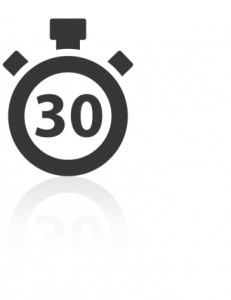12.23.12Ideas in the Making–Doug McCurry’s 3.30.30 Rule
 Doug McCurry, Ed Reform Superstar and CEO of Achievement First emailed me a few weeks ago with an idea he was working on: the 3-30-30 rule. It’s a tool to guide teachers—especially those who are developing their skills and experience—through managing times when students are working independently in the classroom.
Doug McCurry, Ed Reform Superstar and CEO of Achievement First emailed me a few weeks ago with an idea he was working on: the 3-30-30 rule. It’s a tool to guide teachers—especially those who are developing their skills and experience—through managing times when students are working independently in the classroom.
In a nutshell, Doug advises that, at the start of independent work, a teacher should spend the first three minutes setting expectations for work product / process / behavior and then stand sentry (i.e. not circulating actively) where he or she can see 100% of kids to ensure that everyone is on task. That’s the “3.”
Then, once an orderly and productive work environment is established, the teacher should start circulating intentionally: checking-in, doing individual conferencing, holding students accountable for their work, providing guidance, etc. But, Doug suggests, they should do it in 30 second bursts … followed by 30 seconds of group oriented accountability: standing up, scanning the room, using proximity and correcting. The goal is to ensure accountability among the larger class and limit the opportunity of a single student to “draw you in” at the expense of the rest of the class (or students requesting too much help… they need to work independently!).
Those are the two “30”s: 30i, 30 seconds (maximum) interacting with an individual and 30g, 30 seconds monitoring the group. You alternate between the two. Here are some details on what to do and avoid during each part of the 3.30.30 cycle.
| 3-30-30—A User’s Guide | ||
| How to 3 | How to 30i | How to 30g |
| Give clear directions, ones that you planned in advance.Check to see that students understand the task, including (as appropriate) “what to do if you think you are done”
Use non-verbals (“hands down” signal or shake of head) to disengage from students who ask for your time during the “standing sentry” portion of the first three
Try to make it transparent to students that the first three are about getting started. “During the first your job is to do your best; if you ask for my help I’ll say no. I’ll come to check on you later when you get started and show me your best.” |
Use a stop watch to remind yourself when 30 seconds have elapsed!Try to ensure that an equal # of your 30i interactions are initiated by you. Productive interactions need not be talking. Merely reading a student’s work or circling some aspect of it can be very productive.
Privilege communication done in writing rather than spoken. For example a student asks a question and you respond by picking up his paper to read his answer. “Try to explain it here. I’ll come back and tell you if you’re on the right track.”
Give direction and support that prompt the student to return to independent work rather than engage in direct teaching (e.g. ““Go back and look at what Napoleon said earlier about the battle of the barnyard,” rather than “What did Napoleon say earlier about the battle of the barnyard?”)
So speak softly or whisper and/or try to lower your posture (ie squat down) as possible.
Face the majority of the class while you interact with a single student during 30i. Scan the room occasionally. |
If you’ve just finished 30i with a student who is trying to draw more of your attention, walk away during 30g. Say “Keep working”Make occasional statements that emphasize visible compliance: “I should see everyone’s pencil moving. Just like Miranda’s.” But make them quietly. If you are loud you distract students, encourage a response and build a bed of noise that students can exploit for their own conversations.
Use non-verbal positives or very brief positives to acknowledge industrious written work during 30g. “Nice” or a tap on the desk a thumbs up. Occasionally stop to read student work. Stand behind a student when you do so. |

Hi! I’m a new instructional coach and I’m looking for videos that model student/teacher accountability during independent work time. Are there any videos you currently have (or videos in the works?) that show the 3-30-30 technique in action? I feel like this is a great way to help with time management and I’d love to show some examples!
Thanks so much!